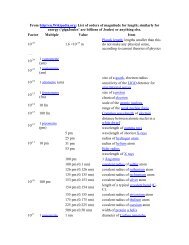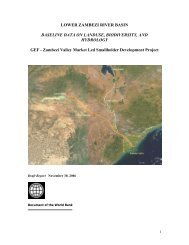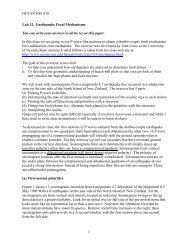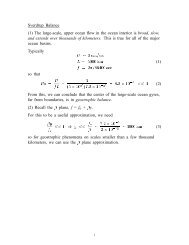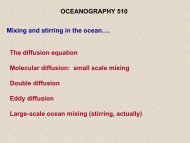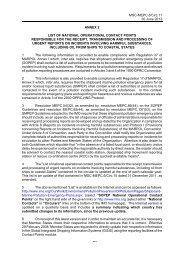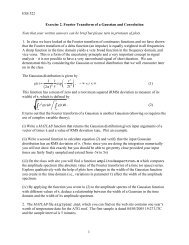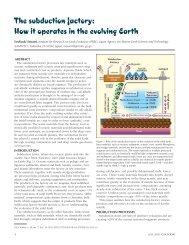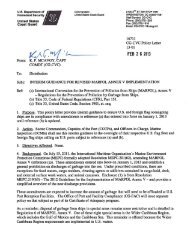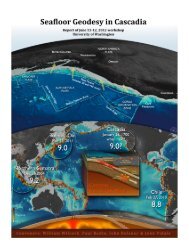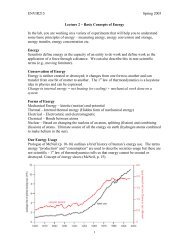16. Sediment Transport Across the Continental Shelf and Lead-210 ...
16. Sediment Transport Across the Continental Shelf and Lead-210 ...
16. Sediment Transport Across the Continental Shelf and Lead-210 ...
Create successful ePaper yourself
Turn your PDF publications into a flip-book with our unique Google optimized e-Paper software.
Solving <strong>the</strong> equation - 2<br />
( )<br />
( )<br />
ln A 1<br />
= ! t<br />
A 2<br />
" t 1<br />
2<br />
( t 2<br />
! t 1 ) = z ! z 2 1<br />
S<br />
( )<br />
ln A 1<br />
= ! z " z 2 1<br />
A 2<br />
S<br />
( )<br />
S = ! z 2 " z 1<br />
ln A 1<br />
A 2<br />
Substitute in <strong>the</strong> relationship between<br />
age <strong>and</strong> depth<br />
An expression for<br />
<strong>the</strong> sedimentation<br />
rate<br />
Pb-<strong>210</strong> sedimentation rates<br />
Plot depth against natural logarithm of Pb-<strong>210</strong> activity<br />
ln(A)<br />
Depth, z<br />
Slope = ! S "<br />
Ignore data with background levels<br />
Ignore data in mixed layer<br />
Summary - How to get a sedimentation rate<br />
1. Identify <strong>the</strong> background (supported) activity A B - <strong>the</strong> value<br />
of A at larger depths where it is not changing with depth.<br />
2. Subtract <strong>the</strong> background activity from <strong>the</strong> observed activities<br />
at shallower depths <strong>and</strong> take <strong>the</strong> natural logarithm to get ln<br />
(A)=ln(A observed -A B )<br />
3. Plot depth z against ln(A).<br />
4. Ignore in <strong>the</strong> points in <strong>the</strong> surface mixed region where ln(A)<br />
does not change with depth.<br />
5. Ignore points in <strong>the</strong> background region at depth<br />
(A observed = A B ).<br />
6. Measure <strong>the</strong> slope in <strong>the</strong> middle region (take it as a positive<br />
value).<br />
7. Multiply <strong>the</strong> slope by <strong>the</strong> radioactive decay constant (λ =<br />
0.0311 yr -1 ) to get <strong>the</strong> sedimentation rate.<br />
Limitations<br />
• Assumption of uniform sedimentation<br />
rates. Cannot use this technique<br />
where sedimentation rate varies with<br />
time (e.g., turbidites).<br />
• Assumption of uniform initial <strong>and</strong><br />
background Pb-<strong>210</strong> concentrations<br />
(reasonable if composition is constant).<br />
6



